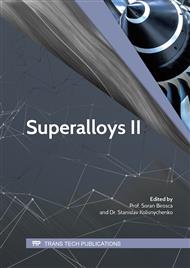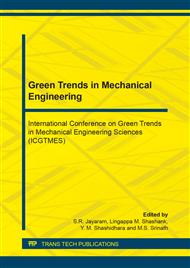[1]
B.V. Cockeram, Some observation of the d-ferrite content on the hardness, galling resistance, and fracture toughness of selected commercially available iron-based hardfacing alloys, Metall. Mater. Trans. 33A (2002) 3403-3419.
DOI: 10.1007/s11661-002-0328-6
Google Scholar
[2]
Agustín Gualco, Hernán G. Svoboda, Estela S. Surian and Luis A. de Vedia, Effect of welding procedure on wear behaviour of a modified martensitic tool steel hardfacing deposit, Mater. Des. 31(2010) 4165-4173.
DOI: 10.1016/j.matdes.2010.04.026
Google Scholar
[3]
S.K. Choi, C.D. Yoo, and Y.S. Kim, Dynamic simulation of metal transfer in GMAW. Part 1: Globular and spray mode welding, Weld. J. 77 (1998) 38-44.
Google Scholar
[4]
S.K. Choi, C.D. Yoo, and Y.S. Kim, Dynamic simulation of metal transfer in GMAW. Part 2: Short circuit transfer mode, Weld. J. 77 (1998) 45-51.
Google Scholar
[5]
Gourd L.M, Principles of welding technology. Viva Books, New Delhi, (1998).
Google Scholar
[6]
Gopa Chakraborty, N. Kumar, C.R. Das, S.K. Albert, A.K. Bhaduri, S.Dash, and A. K. Tyagi, Study on microstructure and wear properties of different nickel base hardfacing alloys deposited on austenitic stainless steel, Surf. Coat. Tech. 244 (2014) 180-188.
DOI: 10.1016/j.surfcoat.2014.02.013
Google Scholar
[7]
Sandeep Singh Sandhu and A.S. Shahi, Metallurgical, wear and fatigue performance of Inconel 625 weld claddings, J. Mater. Proc. Tech. 233 (2016) 1-8.
DOI: 10.1016/j.jmatprotec.2016.02.010
Google Scholar
[8]
M. Hashim, K.E. Sarath Raghavendra Babu, M. Duraiselvam, H. Natu, V. Muthupandi, K. Sivaprasad and K.R. Rajith, Tribological studies on laser surface melted Hastelloy C-276, Surf. Eng. 29 (2013) 531-535.
DOI: 10.1179/1743294413y.0000000145
Google Scholar
[9]
D. Kesavan, M. Kamaraj, The microstructure and high temperature wear performance of a nickel base hardfaced coating, Surf. Coat. Tech. 204 (2010) 4034-4043.
DOI: 10.1016/j.surfcoat.2010.05.022
Google Scholar
[10]
J.J Coronado, H.F. Caicedo, A.L. Gomez, The effect of welding process on abrasive wear resistance of hardfacing deposits, Tribol. Int. 42 (2009) 745-749.
DOI: 10.1016/j.triboint.2008.10.012
Google Scholar
[11]
Manikandan M, Hari P.R, Vishnu G, Arivarasu M, Devendranath Ramkumar K, Arivazhagan N, Nageswara Rao M, and Reddy G.M, Investigation of microstructure and mechanical properties of super alloy C-276 by continuous Nd:YAG laser welding, Procedia Mater. Sci. 5 (2014) 2233-2241.
DOI: 10.1016/j.mspro.2014.07.432
Google Scholar
[12]
Luciano da Silva Ferreira, Karin Graf and Adriano Scheid, Microstructure and properties of nickel-based C-276 alloy coatings by PTA on AISI 316L and API 5L X70 steel substrates, Mater. Res. 18 (2015) 212-221.
DOI: 10.1590/1516-1439.332914
Google Scholar
[13]
Sedriks AJ and Mulhearn TO. The effect of work-hardening on the mechanics of cutting in simulated abrasive processes, Wear 7 (1964) 451–459.
DOI: 10.1016/0043-1648(64)90137-1
Google Scholar



